|
Simply Streep is your premiere online resource on Meryl Streep's work on film, television and in the theatre - a career that has won her acclaim to be one of the world's greatest living actresses. Created in 1999, Simply Streep has built an extensive collection over the past 25 years to discover Miss Streep's body of work through thousands of photographs, articles and video clips. Enjoy your stay and check back soon.
|
In Steven Spielberg’s ‘The Post,’ Meryl Streep brings Katharine Graham’s 1971 decision to have the Washington Post publish the top secret Pentagon Papers to life. However, even with the support of Tom Hanks as editor Ben Bradlee, there’s only so much that one film can include. Here’s the real story behind The Post.

Her success as one of the first women to be a major business leader in the US was all the more remarkable because it was thrust on her in early middle age by a tragic accident. She had reached the age of 46 as a wealthy but diffident housewife, the mother of four children, and the wife of the Washington Post publisher Phil Graham. Then her husband, a close friend of John F Kennedy and Lyndon Johnson, and generally credited with persuading the former to take the latter as his vice-presidential candidate – a decision which many pundits believe made each of them successively president – suddenly blew up. Graham’s husband had been suffering from undiagnosed manic depression for some time. Then he started an affair with a young woman reporter from Newsweek and took her on a Lolita-like tour round the US, ending up at the 1963 convention of the Associated Press, where he grabbed the microphone, made obscene comments and started taking his clothes off. After an appalling succession of escapades and repentances, he returned home, and shot himself. His wife found the body. Warned by all her worldly-wise friends to leave the business, owned by her father before it passed to her husband, to be run by others, Graham decided that she owed it to her children to take over. She did this to such effect that she steered the paper through its transformation into a public company in 1971 and through violent strikes against new technology.
She was the publisher during the paper’s successful legal battle, in alliance with the New York Times, against the Nixon administration’s attempt to prevent them publishing the secret government documents on the origins of the Vietnam war known as “the Pentagon papers”. And she was still at the head of the Post at the time of its triumphant exposure of the various scandals collectively known as Watergate, which forced President Nixon’s resignation and transformed American journalism for ever. Kay Graham, as she was called, was born at the very centre of the expanding imperial America of the ragtime era. Her father, Eugene Meyer, was descended from an eminent family of rabbis and merchants in Alsace; his father was a partner in Lazard Freres, the investment bank. After studying at Berkeley and Yale, Eugene Meyer, too, joined Lazards, but soon founded his own investment company and within a short time was worth several million dollars. He met his future wife Agnes Ernst, the daughter of a German Lutheran family, in an art gallery when she was a student at Barnard College. Agnes Meyer had already formed friendships with several famous people, including the philosopher John Dewey, the photographer Edward Steichen and the painter Georgia O’Keeffe. She had spent a good deal of time in Paris, where she knew the sculptors Brancusi and Rodin and the salon of Gertrude Stein, of whom she did not think much.
All her life Agnes Meyer was a strong-minded, opinionated woman. Kay, her fourth child, not only got on badly with her in a dutiful sort of way, but reacted against her overwhelming style, which was more than a little reminiscent of Margaret Dumont in the Marx brothers’ films. One peculiarity of the family was that the children grew up not only not quite sure whether their father was Jewish, but obliged to ask what being Jewish meant. Partly as a result, Graham identified more closely with her Jewish (though secular) father rather than with her Protestant mother. During the first world war, Eugene Meyer founded the Allied Chemical Company to replace the German aniline dyes that were unobtainable by the American textile industry because of the war. It was said during the Watergate crisis that if Katharine Graham lost control of the Washington Post Company she would be down to her last $600m. Eugene Meyer went down to Washington to serve as the chairman of the War Finance Corporation, so even though the family kept its mansion at Mount Kisco, New York, it was in Washington that Kay Graham grew up, in a world that was just moving from the sedate atmosphere of Henry Adams’s 1880 novel Democracy to that of Gore Vidal’s Washington DC. One of Graham’s best friends at school was President Grant’s granddaughter. After attending Madeira in Virginia, the smartest private school for young ladies, Kay went on to Vassar. She would have liked to go to the London School of Economics, but her father put his foot down and she went to the University of Chicago instead, where she resisted attempts by the young radicals and communists to recruit her, protesting her faith in the capitalist system that had treated her father so well. In 1940 she married Phil Graham, a young man who had made it into the emerging American power elite from the unlikely background of a family who moved from poverty in South Dakota to seek a modest fortune in Florida. He went to a public high school in Miami, then an out-of-the-way southern town, and from there by way of the University of Florida, in even-more-backward Tallahassee, to the Harvard law school and a job, reserved for the most brilliant students, as a clerk to Justice Felix Frankfurter, then at the height of his influence on President Roosevelt and on the American ruling class in general.
By the late 1950s Graham’s husband had succeeded his father-in-law as publisher of the Post and emerged as what would now be called a significant power-broker in Washington. It would seem that his illness, whatever its deeper causes, was aggravated by his feeling that he owed everything to having married his boss’s daughter. The young, brilliant publisher of what became the most powerful newspaper in the capital – after he bought the Times-Herald in 1954 – and his attractive if shy wife were naturally in great demand. With the Kennedy inauguration in 1961, their generation and their friends took over both socially and politically. So when Katharine took responsibility for the family business, just before Kennedy’s assassination, she might be, as she always thought of herself, a mere housewife, inexperienced in the ways of business; but she was also on friendly and in many cases tennis and family-supper terms with most of the inner circle in Washington, and a card-carrying member of that well-born, well-heeled circle that came to be known as “the Georgetown set”. Eugene and Agnes Meyer lived in splendour in the Meridian Park section of Washington, where the pre-war grandees had their homes; the Grahams moved to the simpler elegance of Georgetown, where their mansion more than equalled the Georgian-style homes of the John F Kennedys, the Averell Harrimans, the Joseph Alsops and the other swells. Graham, alone, might find herself the only woman at business meetings, addressed as “lady and gentlemen”. But she had no shortage of contacts and advice from the Robert McNamaras, the McGeorge Bundys and the “great whales” of Congress, while in New York she began to run with the Truman Capote set, graced by such ladies as Pamela Harriman, Babe Paley (wife of the owner of CBS) and Marella Agnelli, whose husband owned Fiat. Her personal friends included the pianist Rudolf Serkin; Adlai Stevenson, whom she did not find as attractive as many other liberal ladies did; Jean Monnet, to whose virility, as she put it rather oddly in her excellent memoirs, she could personally attest; and later Warren Buffett, the immensely successful investor from Omaha who built up a large position in the Washington Post Company’s stock and became Graham’s most trusted business mentor.
In lifestyle and manner, Graham was both genuinely diffident and unmistakably a magnifica, if that is the word for a female magnifico . She could be, as it seemed alternately, charmingly direct and friendly, and aloof, even arrogant. Interviewed in what seemed to her an insufficiently respectful way by the British journalist Henry Fairlie, she reproved him by saying she had been told by no less an authority than McGeorge Bundy that she was the most powerful woman since Queen Victoria. On another occasion, when a newly arrived British ambassador expected her to join the ladies after dinner, she summoned her car and swept imperiously from the embassy. No doubt the truth was that she was lonely and often overwhelmed by the perils threatening her dynasty and her beloved newspaper – perils that she by no means underestimated. She was at first unsympathetic to the tide of feminism which was rising to storm levels in the 1970s, and nowhere more than in the newsrooms of papers and magazines, where talented women found themselves not only professionally discriminated against, but also treated with sometimes brutal insensitivity. The feminist journalist Gloria Steinem, the founder of MS magazine, tried, with little success at first, to interest Graham in the movement. A stronger influence was that of Meg Greenfield, an editorial writer and later editorial page editor of the Post and a columnist for Newsweek, who became Graham’s closest woman friend.
“Though it took me a long time to throw off my early and ingrained assumptions,” she wrote in 1997, in her notably frank and highly successful autobiography, “I did come to understand the importance of the basic problems of equality in the workplace, upward mobility, salary equity and more recently child care.” Although she lived most of her life in an intensely political environment, was generally perceived, especially by conservatives, as a liberal, and indeed proclaimed herself to be a typical “limousine liberal”, her political attitudes and loyalties were more complicated than they seemed to many. Her father, and especially her mother, started out as Republicans, and her husband, before becoming a major Democratic power behind the scenes, voted for the Republican Eisenhower in 1952. At first she made overtures to President Nixon. Then, when her paper was threatened by his administration in the Pentagon papers case and again when the Washington Post Company was in danger of losing its TV franchises during the Watergate battle, she was fiercely antagonistic to the Nixon administration. This was hardly surprising, since Nixon’s vice-president, Spiro Agnew, singled the paper out among the “effete eastern snobs” who dominated the media. And when the young Post reporter Carl Bernstein called Nixon’s attorney general, John Mitchell, to check his involvement in the Watergate affair, Mitchell said: “Katie Graham’s going to get her tit caught in a big fat wringer if that’s published.” During the Watergate crisis, Graham forged a close relationship with Ben Bradlee, the tough, salty-spoken editor she had brought across from Newsweek. Although not directly involved – as she had been in the Pentagon Papers fight, when she personally took the crucial decision to publish the documents – she identified totally with the Post’s investigative reporting. Later, however, she surprised many and disappointed some by forming close friendships with Henry Kissinger and his wife Nancy, and later with Ronald and Nancy Reagan. It would seem that, like many “neo-conservatives” who moved to the right as a result of the wild confrontational politics of the 1970s, Graham’s New Deal loyalties were shaken by her confrontation with the unions, in which the pressmen, in particular, used violent tactics and threatened even uglier attacks.
Certainly, one of her strongest motivations was her commitment to her family and to the media and business empire her father and then her husband had built. It was a great pleasure for her that her daughter, Elizabeth “Lally” Weymouth, worked at the paper before building a career as a freelance journalist, and an even greater satisfaction to be able to hand over the post of chief executive officer of the Washington Post Company in 1991 to her son Don, who had come to the paper only after serving in Vietnam and then working as a District of Columbia police officer. In 1977, she was a member of the Brandt Commission on north-south relations. She was immensely pleased when one of the Third World radicals on the commission made a pass at her. She said her motto was “Never where you work,” and her admirer replied that his was “Never say never.” After her retirement, she travelled widely and sent back interviews with the likes of Mikhail Gorbachev, the Shah of Iran and Muammar Gadafy. She was proud of the fact that Newsweek printed a photo she took of Gadafy, and framed the cheque for the $87.50 she was paid.
In later years Graham spent much time on Martha’s Vineyard, which she loved. She is survived by her daughter Lally and her three sons, Donald, Steve, a New York theatrical producer, and Bill, a lawyer.










